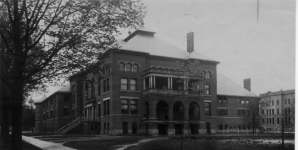Barbour Gymnasium

- Significant funding contributed by the fundraising efforts of the Women's League.
- Erected in recognition of the importance of physical education for women at the University of Michigan.
- Built during 1895 and 1896.
- Architect: John Scott and Co.
- General Contractor: Henry Carew and Co.
- Named in honor of former Regent Levi L. Barbour.
- Demolished in 1977 to make room for the expansion of the Chemistry Building.
[View more images of Barbour Gymnasium]
The campaign for the erection of a gymnasium for women began shortly after the completion of the Waterman Gymnasium for men in 1894. The Women's League, charged with coordinating the campaign, directed the efforts of nearly all the campus' women's organizations toward the goal and raised nearly $21,000.00. The Regents contributed the rest of the $41,341.00 that it cost to construct the gymnasium, which was occupied during 1897.
The architect for the new women's gymnasium was John Scott and Co., with construction supervised by Henry Carew and Co. The Regents' portion of the Building financing came from the sale of land in Detroit given the University by former Regent Levi L. Barbour. In view of this donation, the decision was made at the January, 1898, Regents meeting to name the building for Barbour.
Barbour Gymnasium contained 35,456 square feet of floor space and was built as part of the Waterman Gymnasium building; in fact, the two gyms could be connected by throwing open a set of large doors between them. The initial use of the first floor rooms of the building was as parlors and offices for the Dean of Women and the Department of Physical Education for Women, as well as for social events for women students at the University. The second floor contained the Sarah Caswell Angell Hall which was used by the campus community as a theater.
In 1948, with the construction of a new Administration Building (now the LS&A Building), the offices of the Dean of Women were removed and the gym was turned over completely to women's physical education. The Barbour and Waterman Gymnasium complex experienced considerable physical deterioration during the mid-twentieth century and in 1977 the decision was made to remove the structures to provide room for an expansion to the adjacent Chemistry Building.
The University of Michigan: An Encyclopedic Survey; Walter A. Donnelly, Wilfred B. Shaw, and Ruth W. Gjelsness, editors; Ann Arbor : University of Michigan Press, 1958